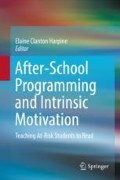Abstract
Our research was complete. During the 8 years of program evaluation, we had learned three things. First, we had learned that all children truly can be taught to read, if you use the right teaching method—even children with learning differences. The group-centered approach combining learning and counseling, intrinsic motivation, and vowel clustering worked and was very successful in helping children who were failing in the schools learn to read at or above their age level—not grade level, age level. Second, we learned that each child is an individual. It is not poverty that causes reading failure; failed teaching methods cause reading failure. Every child can learn, but each child will learn at a different pace. We built 12 teaching techniques into our Reading Orienteering Club program curriculum to accommodate the individual learning needs of each child. Third, we learned that intrinsic motivation is the key to success. Even though it is not possible to motivate a student, it is possible to create an intrinsically motivational environment that encourages students to try again after failing in the classroom. All of the students that we worked with were failing in reading at school. We incorporated six counseling strategies into our curriculum to help create that intrinsically motivating environment and engage the full healing power of group process. Yes, we really can teach every child to read. Failure is not the children but the teaching method being used in the classroom.
Access this chapter
Tax calculation will be finalised at checkout
Purchases are for personal use only
References
Chronis-Tuscano, A., Rubin, K. H., O’Brien, K. A., Coplan, R. J., Thomas, S. R., Dougherty, L. R., et al. (2015). Preliminary evaluation of a multimodal early intervention program for behaviorally inhibited preschoolers. Journal of Consulting and Clinical Psychology, 83, 534–540. https://doi.org/10.1037/a003-9043
Clanton Harpine, E. (2013). Erasing failure in the classroom, vol. 3: The Reading Orienteering Club, using vowel clustering in an after-school program. North Augusta, SC: Group-Centered Learning.
Clanton Harpine, E., & Reid, T. (2009). Enhancing academic achievement in a Hispanic immigrant community: The role of reading in academic failure and mental health. School Mental Health, 1, 159–170. https://doi.org/10.1007/s12310-009-9011-z
Foorman, B. R., Herrera, S., Petscher, Y., Mitchell, A., & Truckenmiller, A. (2015). The structure of oral language and reading and their relationship to comprehension in kindergarten through grade 2. Reading and Writing, 28, 655–681. https://doi.org/10.1007/s11145-015-9544-5
Kazdin, A. E. (2010). Single-case research designs: Methods for clinical and applied settings. New York: Oxford University Press.
Keller, T. A., & Just, M. A. (2009). Altering cortical connectivity: Remediation-induced changes in the white matter of poor readers. Neuron, 64, 624–631.
Lyon, G. R. (April 28, 1998). Overview of reading and literacy initiatives. Testimony before the Committee on Labor and Human Resources, Senate Dirkson Building. Retrieved November 27, 2006, from http://www.cdl.org/resource-library/pdf/lyon_testimonies.pdf
Meyler, A., Keller, T. A., Cherkassky, V. L., Gabrieli, J. D., & Just, M. A. (2008). Modifying the brain activation of poor readers during sentence comprehension with extended remedial instruction: A longitudinal study of neuroplasticity. Neuropsychologia, 46, 2580–2592.
National Center for Education Statistics [NCES]. (2018). The condition of education 2018 (NCES 2018–144). Washington, DC: Institute of Education Sciences, US Department of Education.
Ouellette, G., & Beers, A. (2010). A not-so-simple view of reading: How oral vocabulary and visual word recognition complicate the story. Reading and Writing, 23, 189–208.
Rappaport, J., & Seidman, E. (Eds.). (2000). Handbook of community psychology. New York: Kluwer Academic Plenum Publishers.
Royse, D., Thyer, B. A., & Padgett, D. K. (2016). Program evaluation: An introduction to an evidence-based approach (6th ed.). Boston, MA: Centage Learning.
Shaywitz, S. (2003). Overcoming dyslexia: A new and complete science-based program for reading problems at any level. New York: Knopf.
Acknowledgments
-
1.
Special appreciation to Keri Weed, Ph.D. and Meredith Elzy, Ph.D., University of South Carolina Aiken, for allowing their students to work on the project.
-
2.
A special thank you to St. John’s United Methodist Church in Aiken for providing community volunteers and financial sponsorship, and allowing us to use classroom space for this project.
-
3.
Thomas Reid, Ph.D., is Assistant Professor of Mathematical Sciences at the University of South Carolina Aiken.
-
4.
Elaine Clanton Harpine, Ph.D., was the director of the Camp Sharigan Project for 8 years. She developed the Camp Sharigan and Reading Orienteering Club programs and created the program packets for both programs.
Author information
Authors and Affiliations
Editor information
Editors and Affiliations
Rights and permissions
Copyright information
© 2019 Springer Nature Switzerland AG
About this chapter
Cite this chapter
Reid, T., Clanton Harpine, E. (2019). Why Does Group-Centered Prevention Work When Other After-School Programs Fail? What Is the Role of Intrinsic Motivation? Retesting and Another Success Story. The 2016–2017 Group Report. In: Clanton Harpine, E. (eds) After-School Programming and Intrinsic Motivation. Springer, Cham. https://doi.org/10.1007/978-3-030-22845-3_10
Download citation
DOI: https://doi.org/10.1007/978-3-030-22845-3_10
Published:
Publisher Name: Springer, Cham
Print ISBN: 978-3-030-22844-6
Online ISBN: 978-3-030-22845-3
eBook Packages: Behavioral Science and PsychologyBehavioral Science and Psychology (R0)

